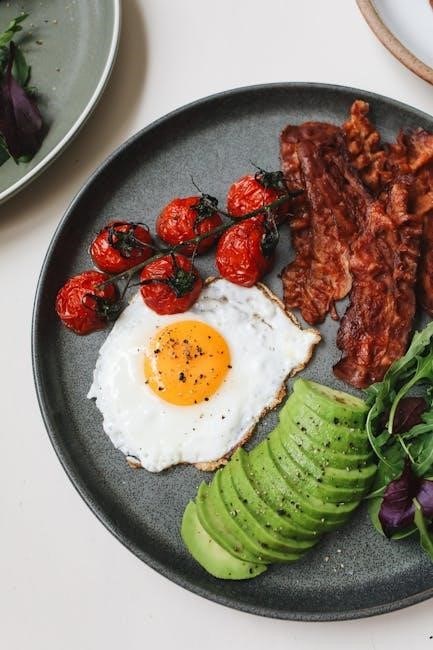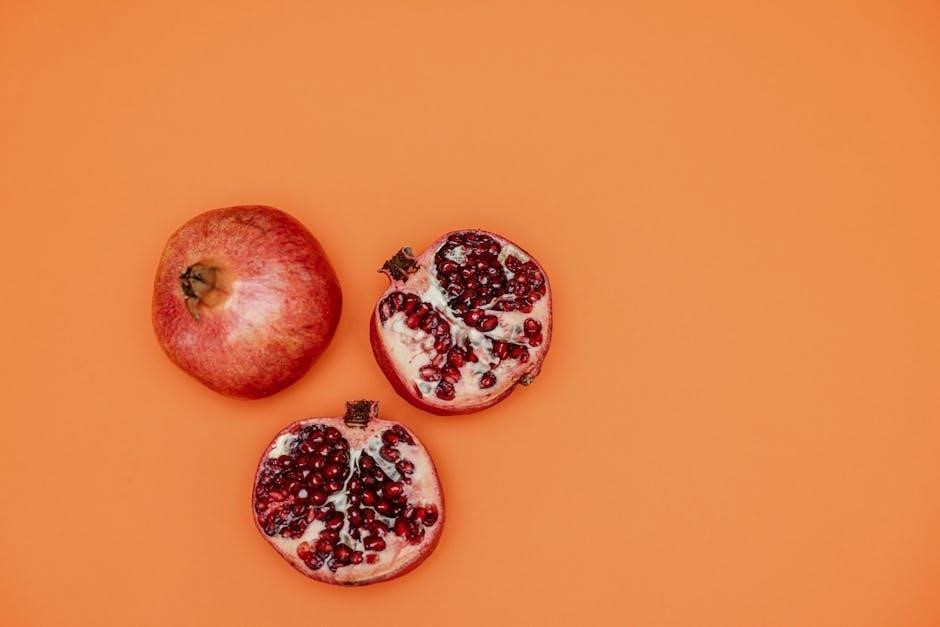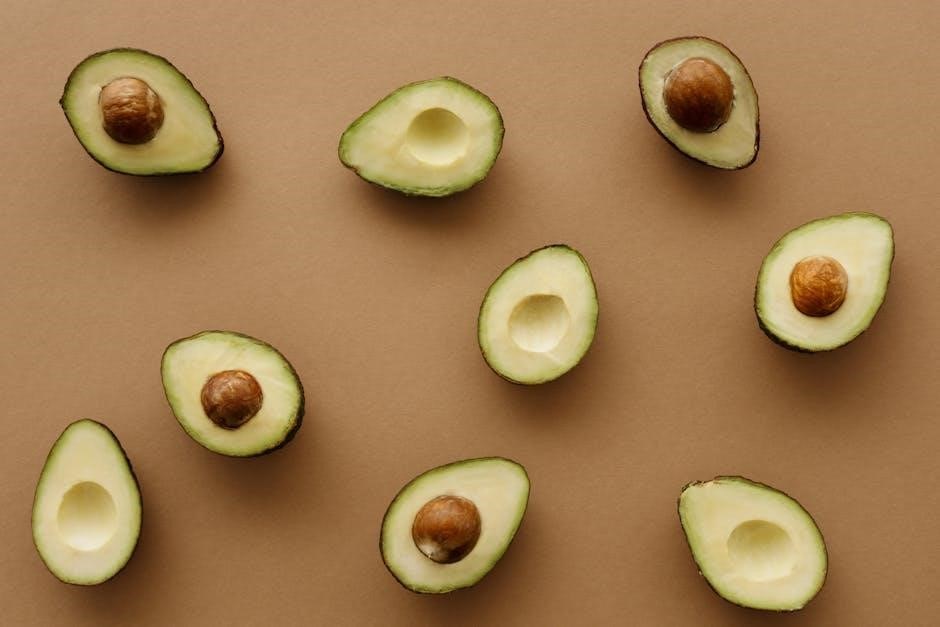A low-fat diet restricts fat intake, often prescribed for medical conditions like liver or heart disease. It balances calorie reduction with essential nutrient intake for overall health.
What is a Low-Fat Diet?
A low-fat diet limits dietary fat intake, typically to 40-45 grams per day, and is often recommended for medical conditions like liver or heart disease. It emphasizes foods labeled as “fat-free” or “low-fat,” which contain 3 grams or less of fat per serving. This diet focuses on nutrient-dense foods, such as lean proteins, whole grains, and fruits, while restricting high-fat items like fried foods and full-fat dairy. It aims to reduce calorie intake and support overall health by balancing fat restriction with essential nutrient consumption.
Importance of a Low-Fat Diet for Health
A low-fat diet is crucial for managing health conditions like heart disease and fatty liver, as it reduces fat digestion and absorption issues. By limiting fat intake, it helps lower cholesterol levels and promote weight management. This diet supports overall well-being by minimizing the risk of chronic diseases and ensuring adequate nutrient intake from lean proteins, whole grains, and fruits. It is particularly beneficial for those requiring medical supervision to maintain a balanced and healthy lifestyle.

Food Groups in a Low-Fat Diet
A low-fat diet emphasizes lean proteins, whole grains, fruits, vegetables, and low-fat dairy, providing balanced nutrition while minimizing fat consumption for optimal health benefits.
Lean Proteins: Chicken, Turkey, and Fish
Lean proteins like chicken, turkey, and fish are essential in a low-fat diet, providing ample nutrition without excess fat. Opt for skinless poultry to reduce saturated fat intake. Fish, especially fatty fish like salmon, offers omega-3 fatty acids, supporting heart health. Egg whites and low-cholesterol substitutes are also excellent choices. These proteins are versatile, suitable for grilling, baking, or steaming. Portion control is key, with a recommended serving size of 6 ounces per day. Incorporating these into meals ensures a balanced and satisfying low-fat diet.
Whole Grains: Breads, Cereals, and Pasta
Whole grains like whole wheat bread, oats, and brown rice are rich in fiber, vitamins, and minerals, making them ideal for a low-fat diet. They provide sustained energy and support digestion. Opt for whole grain cereals and pasta to increase nutrient intake without adding excess fat. Choose breads like pumpernickel or whole wheat and pair pasta with light, vegetable-based sauces. These foods are versatile and can be incorporated into meals for a balanced and nutritious low-fat diet. Portion control is essential to maintain calorie balance.
Fruits and Vegetables: Rich in Fiber and Nutrients
Fruits and vegetables are essential in a low-fat diet, offering fiber, vitamins, and minerals while being naturally low in fat. They support digestion and overall health. Incorporate a variety of colorful options like berries, citrus fruits, leafy greens, and cruciferous vegetables. These foods add natural sweetness and texture to meals without excess calories. Their high water content and fiber help with satiety, making them ideal for weight management. Include them in salads, snacks, or as sides to enhance nutrient intake and balance your diet effectively.
Dairy Products: Low-Fat and Fat-Free Options
Low-fat and fat-free dairy products are excellent choices for a low-fat diet. Options like skim milk, nonfat yogurt, and reduced-fat cheese provide essential calcium and protein without the excess fat. These products support heart health by reducing saturated fat intake. Always check labels to ensure they meet low-fat criteria, typically containing less than 3 grams of fat per serving. Incorporating these into meals and snacks helps maintain nutritional balance while adhering to a low-fat dietary plan. They are versatile and can be used in cooking or consumed directly.

Cooking Methods for Low-Fat Meals
Grilling, steaming, and baking are ideal for low-fat meals. These methods avoid excess oil, helping retain nutrients while keeping dishes flavorful and healthy. Trimming visible fat ensures a leaner outcome.
Grilling, Steaming, and Baking
Grilling, steaming, and baking are excellent cooking techniques for low-fat meals. Grilling enhances flavor without added fats, while steaming preserves nutrients and cooks food gently. Baking uses minimal oil, making it a healthy alternative to frying. These methods help retain the natural flavors and nutritional value of ingredients, ensuring meals are both delicious and healthy. Incorporating these techniques into your routine can make your low-fat diet more enjoyable and sustainable.
Fried foods and high-fat cooking methods should be avoided in a low-fat diet. Fried foods, such as fries and doughnuts, are high in calories and saturated fats, which can hinder weight management and heart health. Similarly, using butter, oil, or cream in cooking adds unnecessary fat. Opting for non-stick pans and minimal oil can help reduce fat intake. Avoiding these techniques ensures meals remain low in fat while promoting better overall health and adherence to dietary goals. Creating a weekly meal plan and using a grocery list helps maintain a low-fat diet. Choose fat-free or low-fat options, and read nutrition labels to ensure compliance. Planning meals weekly ensures adherence to a low-fat diet. Start by listing healthy options like lean proteins, whole grains, and vegetables. Consider breakfast, lunch, dinner, and snacks. Use a low-fat diet food list PDF for ideas. Include a variety of fat-free and low-fat foods to keep meals interesting. For example, incorporate grilled chicken, fish, and plant-based proteins. Pair with fiber-rich sides like whole grains or steamed vegetables. Snacks could include fruits or low-calorie, low-fat options. Adjust portion sizes based on calorie needs. A structured plan helps avoid high-fat choices and keeps meals balanced. Understanding food labels is crucial for a low-fat diet. Always check the Nutrition Facts Table to see the total fat per serving. Fat-free or low-fat claims can guide choices, but verify the grams of fat. Be mindful of serving sizes, as multiple servings can add up. Avoid products listing high-fat ingredients like butter or oil. Opt for items with less than 3 grams of fat per serving to stay within your daily limit. This helps maintain a balanced and healthy low-fat diet effectively. A low-fat diet promotes weight management and improves heart health by reducing cholesterol levels. It also lowers the risk of chronic diseases like diabetes and certain cancers. A low-fat diet aids in weight management by reducing overall calorie intake, as fats are calorie-dense. By focusing on lean proteins, whole grains, and fiber-rich foods, it helps control hunger and portion sizes. This approach supports sustainable weight loss while maintaining essential nutrients. The low-fat diet food list PDF provides guidance on selecting meals that are both nutritious and calorie-conscious, ensuring a balanced intake for long-term health benefits; A low-fat diet significantly benefits heart health by reducing saturated fat and cholesterol intake, which can lower LDL (“bad”) cholesterol levels. This helps prevent plaque buildup in arteries, decreasing the risk of heart disease. Emphasizing lean proteins, whole grains, and fiber-rich foods supports overall cardiovascular well-being. The low-fat diet food list PDF guides selections that promote healthier cholesterol levels, contributing to a stronger, healthier heart and reducing the likelihood of cardiovascular complications over time. High-fat snacks, fried foods, and processed items should be avoided as they contain excessive fat and calories, hindering weight management and heart health goals. High-fat snacks, such as potato chips, doughnuts, and fried items, are rich in calories and saturated fats, contributing to weight gain and heart disease. Processed foods like sausages, pastries, and ready-to-eat meals often contain hidden fats and preservatives. These foods should be minimized or avoided to maintain a healthy, balanced low-fat diet. Opt for whole, nutrient-dense options instead to support overall health and weight management. Fried foods, such as fries and doughnuts, are high in saturated fats and calories, increasing the risk of heart disease. High-fat dairy products like cheese, whole milk, and cream should be avoided. These foods can hinder weight management and raise cholesterol levels. Incorporating low-fat dairy and baked or grilled alternatives helps maintain a balanced diet. Always check food labels to ensure fat content aligns with your dietary goals.
Adopting a low-fat diet promotes better health and weight management. By choosing nutrient-rich, low-fat options and avoiding fried foods, you can achieve a balanced lifestyle effectively. A low-fat diet emphasizes reducing fat intake to improve health and manage weight. Focus on lean proteins, whole grains, fruits, and vegetables. Avoid fried foods and high-fat snacks. Choose fat-free or low-fat dairy products and read food labels for fat content. Meal planning and grocery shopping strategies help maintain this diet. Health benefits include improved heart health and cholesterol levels. Consulting a healthcare provider ensures a personalized approach. Balancing nutrition while limiting fat intake supports overall well-being. Plan meals weekly and shop for nutrient-dense foods. Read food labels to monitor fat content. Avoid fried foods and opt for grilling or steaming. Incorporate lean proteins, whole grains, and plenty of fruits and vegetables. Limit high-fat snacks and choose fat-free dairy products. Stay hydrated and use herbs for flavor instead of fats. Consult a dietitian for personalized guidance. Track your fat intake with a food diary to stay accountable. Consistency and mindful eating are key to achieving long-term success on a low-fat diet.Avoiding Fried and High-Fat Cooking Techniques
Meal Planning and Grocery Shopping
Creating a Weekly Meal Plan
Reading Food Labels for Fat Content

Health Benefits of a Low-Fat Diet
Weight Management and Reduced Calories
Improved Heart Health and Cholesterol Levels

Foods to Avoid in a Low-Fat Diet
High-Fat Snacks and Processed Foods
Fried Foods and High-Fat Dairy Products
Final Tips for Success on a Low-Fat Diet
